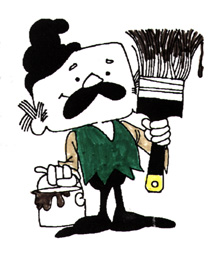|
Guidelines To Wet-Mounting Display Projects Part 2 — Graphic Mounting Options |
|
|
Substrates, mediums, and methods used to effectively mount specific materials come in a variety of choices. Procedures stressed in this document can be accomplished locally, using materials and tools which are simple and widely available. This work can be performed in any area that has a large worktable, running water, room temperature control, and reasonable ventilation. Mounting Substrates: There are numerous materials available on the market which can be used for display-panel mounting, including matte board, plastic panels, foamboard, masonite, and newer ultra-light fiberglass and trade-named materials. Weight, durability, mounting method used, and the materials to be mounted all play a part in selecting mounting substrates. Many of these materials are more amenable to hot or cold press mounting. As we are dealing largely with wet-mounting procedures, only mounting substrates that serve this purpose well will be covered in this presentation. Smooth-surface Masonite makes an ideal and inexpensive wet-mount base. A fiberglass-reinforced foam board, called “Feather-board” is ultra light and very appropriate. Its disadvantage is that extra caution must be taken when working with this material with a utility knife, sandpaper and table saw. The operator must have mask protection from fiberglass dust and it is good if the table saw system has a dust vacuum system installed for further protection. When mounting processes are completed and the acrylic finish has had adequate curing time, final trimming of the displays displays can be accomplished with a fine-toothed, table-saw blade. The final dressing of the mounts can be completed with a small sanding block using a fine-grade sandpaper. |
|
 |
Mounting Mediums: The following liquid-mount, spray-mount and dry- mount products are potentials for use in your display fabrication: 1) Base (primer) coat Materials: A white or gray acrylic or latex paint will work satisfactorily. Artist’s Gesso is also a fine product for this purpose. A small jar or tube of artist’s acrylic modeling paste will come in handy to refine some applications. 2) Liquid Mount and Finishing Materials: Fully adequate and readily available products found in most art-supply stores, is an acrylic polymer transparent medium, usually used by artists. It makes an ideal transparent medium for wet mounting art prints and photographs with easy water cleanup. It has the consistency of very soft toothpaste, and is available in tubes and jars. These acrylic products have a milky appearance, but become clear in the drying process. One can use Artist’s Acrylic Matte Medium for the initial mounting process and Matte Varnish for the final two coats of finish. I have used Matte Varnish for the entire process with good success. |
|
3) Spray Mount Materials: Liquid mounting provides a clean, strong bond and a potential for computability with application of a protective matte-varnish finish. There may be times when spray mounting will meet your special needs when dealing with certain delicate materials in a more appropriate manner. When this is the case, be sure the work is done in a well-ventilated environment, taking the special precautions necessary when using flammable spray materials. I have successfully used spray mounting procedures to create individual picture displays such as shown on Display Review Page 1, with follow-on treatments of fixative spray to seal the art work. This done and fully dried, I have finished an acrylic paint-decorated Masonite matte and the overlaid picture panel with liquid acrylic varnish without damaging the product.
|
|
Wet Mounting Procedures: You will recall that when you reviewed the wet-mounted illustrations, they included examples of individual mounts, multiple mounts and collage mounts. The instructions which follow take you, step-by-step through the creation of an individual mount display panel. These procedures easily translate to the multiple mount and will complement later instructions regarding collage display creation.
WET MOUNTING TECHNIQUES: Single Photograph or Durable Art-Print Wet Mounting and Matting: a. For a water-based glue mount: Paint a thin coat of glue on both surfaces. Press in place. Mop up edges and wring out the sponge. If you wish to place a light weight on the picture surface to hold it in place during the drying process, be sure to insert a layer of wax paper between the picture and the weight. Use a weight with a flat surface to prevent denting of the still-curing surface of the acrylic mount. 20. Let mounts dry overnight. When you get back to the project, run a bead of white or yellow glue along each of the four joined edges so it can fill any gaps and provide added strength. Brush or wipe the joint to eliminate any excess. When dry, this will provide a better surface for the final decoration process. Artist’s modeling paste could be used as a substitute for the glue. This completes the section on wet-mounting individual or multiple individual pictures and art prints. You are invited to move on to Part 3 which will deal with collage creation, using these same materials. |
|
|
Go to Wet-Mounting Display Review Pages Go to Wet-Mounting Procedures & Techniques Instruction Table of Contents Go to Wet-Mounting Procedues and Techniques Introduction Go to Education Programs Home Page — Return to RB-29 Home Page |
|